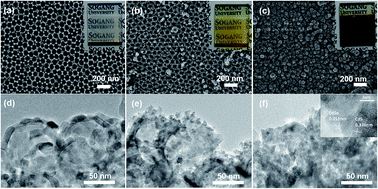Bilayer quantum dot-decorated mesoscopic inverse opals for high volumetric photoelectrochemical water splitting efficiency†
Abstract
Nanostructured heterojunction semiconductor/metal oxide electrodes are desired for use in efficient photoelectrochemical (PEC) water splitting. We introduced a mesoscopic IO (meso-IO) structure and sensitized the TiO2 IO structure using a CdSe/CdS nanoparticle bilayer for use as PEC water splitting electrodes. The CdS nanoparticle shell was deposited on the IO surface using successive ionic layer absorption and reaction and subsequently, the CdSe layer was grown by chemical bath deposition. The CdSe/CdS double layer sensitization revealed the extension of visible light absorption up to 680 nm. The meso-IO structures provide an ideal geometry for highly compact composite materials; the CdSe/CdS meso-IO TiO2 structure produced a highly compact film with a volume fraction of approximately 82%. Thus, upon application as a PEC water splitting electrode, due to this highly compact structure, the CdSe/CdS meso-IO TiO2 electrodes exhibit a high volumetric photocurrent density of 1.95 mA cm−2 μm−1, which was higher than any previous reports in the literature. Moreover, we obtained improved long-term stability during water splitting: the CdSe/CdS meso-IO TiO2 electrode that was decorated using 3 at% iridium oxide colloidal particles displayed a photocurrent of 98% of the initial photocurrent for 2 h.


 Please wait while we load your content...
Please wait while we load your content...